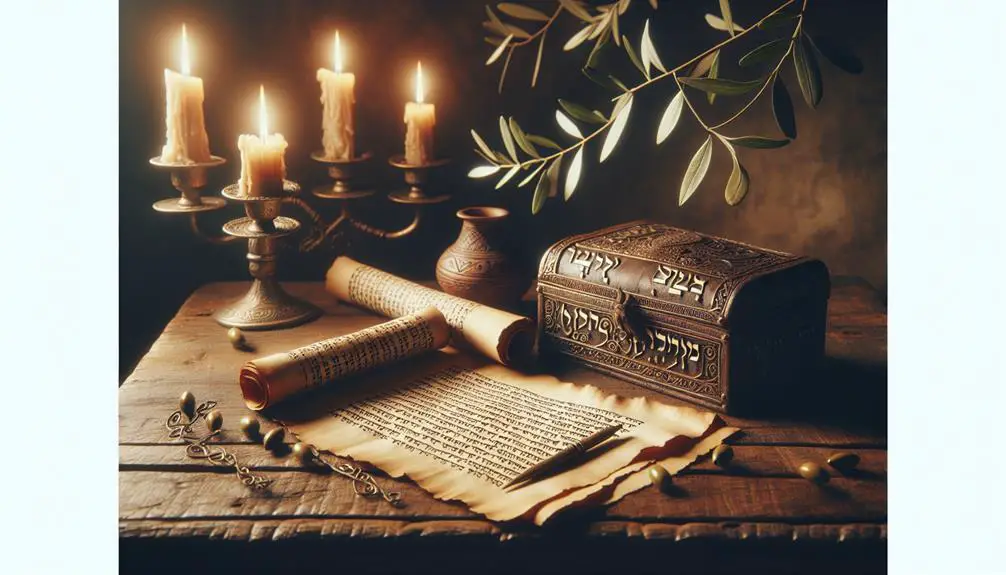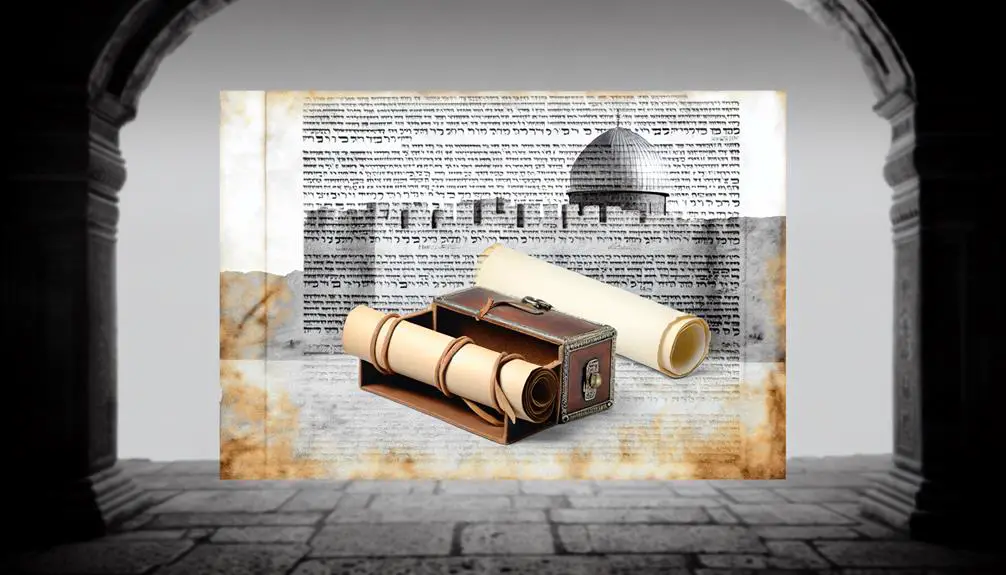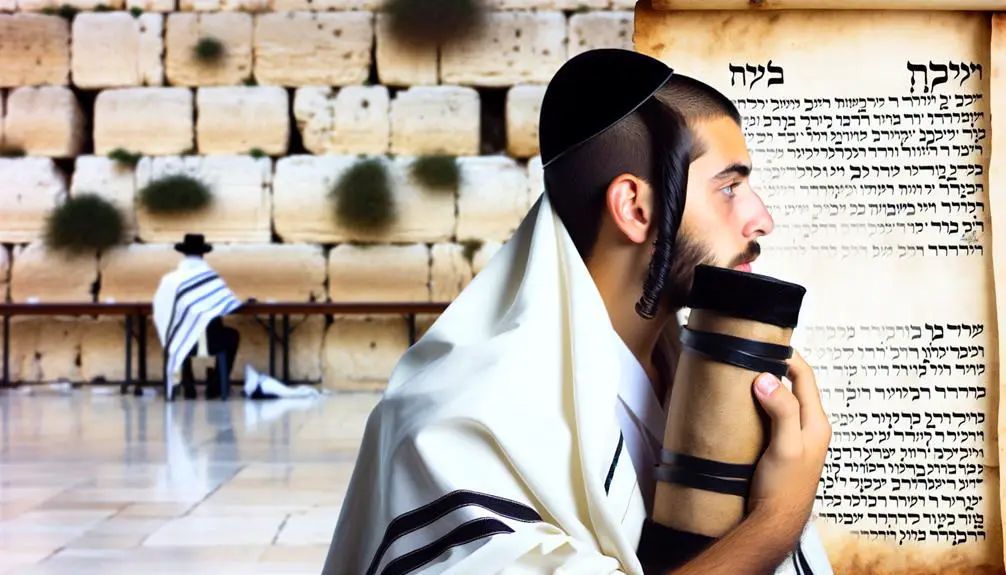Unlock the spiritual symbolism and historical significance of phylacteries in the Bible, and explore their enduring impact on faith.

Phylacteries Meaning in the Bible
In the sacred texts, phylacteries are more than just a footnote; they're a bridge to understanding the devout practices of ancient times. You may find yourself intrigued by these small, yet significant objects mentioned in the Bible.
They not only carry historical weight but also embody deep spiritual symbolism that has transcended centuries. As you explore the origins, biblical references, and the intricate components and construction of phylacteries, you'll uncover layers of symbolic interpretations and their enduring impact on modern practices and culture.
This journey offers a unique lens through which to view the interplay between tradition and faith, inviting you to uncover the profound significance these artifacts hold in the tapestry of religious history.
Key Takeaways
- Phylacteries symbolize remembrance and adherence to divine commandments as outlined in Exodus and Deuteronomy.
- They represent a physical and spiritual bond with God, emphasizing commitment and covenant.
- Crafted from kosher leather and inscribed with Torah verses, phylacteries are tangible links to Jewish heritage.
- Wearing phylacteries is a visible expression of faith, connecting individuals to ancient traditions and religious duties.
Historical Origins

Delving into the historical origins of phylacteries, it becomes evident that their use is deeply rooted in ancient Jewish practice, tracing back to biblical commandments. Through an etymology exploration, you'll find that the term 'phylactery' derives from the Greek word 'phylakterion,' meaning safeguard or amulet. This linguistic journey not only sheds light on how phylacteries were perceived in antiquity but also highlights their protective and spiritual significance.
As you delve further, a comparative religions approach reveals that while phylacteries are unique to Judaism, the concept of carrying or wearing objects for spiritual protection or connection is a universal theme. This cross-cultural perspective enriches your understanding of phylacteries, placing them within a broader context of human spirituality and practice.
In analyzing their origins, it's clear that phylacteries aren't merely ancient artifacts but alive with historical, cultural, and religious meaning. Their enduring presence within Jewish life speaks to a deep-seated tradition of faith, identity, and devotion. This exploration into their roots offers a profound insight into not just phylacteries themselves but the very nature of religious practice and belief across ages and cultures.
Biblical References
As you explore the biblical references to phylacteries, you'll find significant mentions in Exodus and Deuteronomy that illuminate their usage and symbolic importance.
These texts provide a foundation for understanding how phylacteries functioned not only as physical objects but also as potent symbols of faith and identity among ancient Israelites.
Phylacteries in Exodus
In examining the Book of Exodus, you'll find that phylacteries, though not explicitly named, are deeply rooted in several passages that underscore the importance of remembrance and adherence to divine commandments. These texts hint at the ritual significance of phylacteries and their role in daily life, as well as in artistic depictions of religious observance.
Reference |
Implication |
Connection to Phylacteries |
|---|---|---|
Exodus 13:9 |
A sign on the hand and reminder on the forehead |
Symbolic of phylacteries' physical placement |
Exodus 13:16 |
A mark of God's law |
Echoes the ritual significance |
Exodus 12:14 |
Remembering through generations |
Reflects the purpose of phylacteries |
Exodus 31:13 |
Observing as a sign |
Ties to the covenant and phylacteries' role |
These passages illuminate the integral role of phylacteries in embodying and perpetuating the sacred traditions and commandments.
Usage in Deuteronomy
Turning our attention to the Book of Deuteronomy, it's pivotal to understand how this text expands the concept of phylacteries, emphasizing their role in the daily life and spiritual practice of the faithful.
Deuteronomy intricately weaves the commandment significance of phylacteries within its narrative, framing them not just as physical objects but as symbols of a covenant deeply rooted in memory and identity.
Through the use of agricultural metaphors, the text connects the practice of wearing phylacteries to the cultivation of a spiritual landscape, where the seeds of commandments grow into a bountiful harvest of faith and devotion.
This portrayal enriches our comprehension of phylacteries, positioning them as vital instruments in the nurturing of a devout life, tethered to the rhythms of agricultural and spiritual renewal.
Components and Construction

Phylacteries, often meticulously crafted, consist of small leather boxes containing verses from the Torah, demonstrating the deep intertwining of physical artisanship and spiritual significance. The creation of these sacred objects is governed by specific material sources and crafting rituals, ensuring their sanctity and functionality.
To understand their construction fully, consider the following components:
- Leather Boxes: Sourced from kosher animals, these boxes are emblematic of purity and adherence to Jewish dietary laws. The quality of the leather and the precision in crafting underscore the devotion and meticulousness required in their making.
- Parchment Scrolls: Inside each box are small scrolls of parchment, upon which specific Torah verses are inscribed. This requires a skilled sofer (scribe) who follows stringent rituals in writing, embodying a profound connection between divine commandments and the scribe's craftsmanship.
- Straps: Made from the same kosher leather as the boxes, the straps are dyed black and wrapped in a specific manner during prayer. This component not only secures the phylacteries in place but also symbolizes the binding of oneself to God's laws.
The construction of phylacteries is a complex process that blends material selection, artisanal skill, and religious observance, reflecting their profound significance in Jewish tradition.
Symbolic Interpretations
Delving into the symbolic interpretations of phylacteries reveals layers of spiritual and cultural significance that transcend their physical components. These small, leather boxes, bound to the body during prayer, aren't just ritualistic objects. They're laden with esoteric symbolism, each aspect meticulously crafted to serve as a conduit for profound spiritual truths.
To understand phylacteries, you must see them as more than mere containers of holy scripture. They embody the mystical interpretations of faith, acting as tangible reminders of one's commitment to spiritual discipline. The act of binding them to one's body symbolizes the unbreakable bond between the individual and the divine, signifying that the teachings of the Torah are to be kept close to the heart and mind at all times.
This practice, steeped in tradition, serves as a portal to the divine, with each component—the box, the straps, the verses within—carrying deep symbolic meanings. Through the lens of mystical interpretations, phylacteries aren't just physical artifacts but keys to understanding the esoteric aspects of faith, offering insights into the ways spiritual principles can be woven into the fabric of daily life.
Modern Practices

While exploring the symbolic interpretations of phylacteries enriches our understanding of their spiritual significance, examining how these practices have evolved into modern times offers a fresh perspective on their role in contemporary religious life. The transition of phylacteries from ancient to modern practices highlights a dynamic interplay between tradition and innovation, sparking contemporary debates and leading to various ritual adaptations.
Here are three ways in which modern practices of phylacteries reflect this evolution:
- Integration with Technology: Innovations, such as apps for studying their texts, reflect how tradition meets modernity. This synergy enables practitioners to engage with phylacteries in ways that were unimaginable in the past, thus revitalizing their spiritual significance.
- Gender Inclusivity: Contemporary debates around gender inclusivity have led to discussions about women's participation in wearing phylacteries. This conversation signifies a broader shift towards inclusivity within religious practices, challenging traditional norms.
- Ritual Adaptations: Modern life demands flexibility, leading to adaptations in the ritual's timing and context. These changes reflect an ongoing negotiation between adhering to religious obligations and accommodating the realities of contemporary life, ensuring the practice remains relevant and accessible.
Cultural Impact
The cultural impact of phylacteries extends beyond their religious significance, influencing art, literature, and communal identity in profound ways. You'll find that these small, yet potent, symbols carry a weight of meaning that transcends their original religious context. They've become a beacon of religious symbolism, embodying the deep-rooted traditions and beliefs that have shaped communities over millennia. Their presence in various forms of artistic expression speaks to their enduring legacy and contemporary relevance.
Medium |
Example |
Impact |
|---|---|---|
Literature |
Biblical narratives |
Highlights religious devotion and identity |
Visual Arts |
Renaissance paintings |
Symbolizes piety and religious adherence |
Modern Media |
Films & Documentaries |
Brings ancient practices to contemporary audiences |
Education |
Religious studies |
Facilitates understanding of Jewish customs |
Community Events |
Cultural festivals |
Promotes unity and shared heritage |
Through this table, you can see how phylacteries have woven themselves into the fabric of cultural consciousness, serving as an enduring symbol of faith and tradition. Their role in art and literature not only enriches the aesthetic and narrative depth but also offers a window into the spiritual life and historical continuity of the Jewish people, illustrating the profound connection between religion, culture, and identity.
Frequently Asked Questions
How Do Different Christian Denominations View the Use of Phylacteries Compared to Jewish Practices?
You'll find that Christian denominations generally don't adopt phylacteries in their practices, diverging from Jewish traditions. This difference stems from varied cultural interpretations and historical origins of religious texts.
While Jews view phylacteries as a physical manifestation of faith and commandment observance, Christians typically interpret scriptural commands more metaphorically, focusing on the spiritual rather than the physical adherence.
This analytical insight highlights the complex interplay between religious practices and cultural contexts.
Are There Specific Prayers or Rituals Associated With Disposing of Old or Damaged Phylacteries, Similar to Other Religious Texts or Items?
When disposing of old or damaged phylacteries, you'll find that specific prayers or rituals often reflect a blend of environmental considerations and historical disposal methods. This process isn't taken lightly. Traditionally, these items are treated with great reverence, acknowledging their sacred role.
Insightfully, the disposal methods have evolved, yet they always ensure respect for both the item and the environment, demonstrating a deep, scholarly understanding of their significance and proper care.
How Do Contemporary Artists and Writers Incorporate the Concept of Phylacteries Into Their Works to Explore Themes of Faith, Identity, or Memory?
You're diving into a creative ocean where contemporary artists and writers wield the concept of phylacteries like magic wands. Through artistic reinterpretation, they're not just exploring faith and identity; they're weaving these ancient symbols into their narratives to underscore themes of memory preservation.
This isn't just about keeping traditions alive; it's about redefining them, making ancient practices resonate with modern souls searching for meaning in a rapidly changing world.
In What Ways Have Technological Advancements Impacted the Production or Personalization of Phylacteries for Today's Faithful?
Technological advancements have revolutionized phylacteries' production and personalization. Digital customization allows you to tailor their appearance and content, making them more meaningful to you.
Material innovations have introduced durable and lightweight materials, enhancing their wearability and longevity. These advancements not only deepen your connection to your faith but also ensure that these sacred items reflect your personal identity and beliefs, marrying tradition with modernity in a seamless manner.
Can the Wearing of Phylacteries Be Adapted for Those With Disabilities or Special Needs to Ensure Inclusivity and Participation in This Religious Practice?
Certainly, crafting customizable carriers can considerably contribute to creating a more inclusive religious experience. By integrating accessibility adaptations, you ensure that everyone, regardless of their physical abilities, can participate fully.
Inclusive practices in the design and wearing of these items allow for adjustments to accommodate various needs. This approach not only respects individual differences but also enriches the communal aspect of observance, making it a profoundly personal yet shared experience.
Conclusion
In sum, phylacteries, those quaint yet profound relics, have traversed the annals of time like celestial chariots, illuminating the path from ancient scrolls to modern spirituality. They're not merely artifacts; they're the DNA of divine dialogue, encapsulating an entire cosmos of faith within their minuscule confines.
Today, they stand as titanic symbols in the microcosm of religious practice, their influence undiminished, echoing the divine whisper through the ages. Truly, in the grand tapestry of culture and belief, phylacteries are the warp and weft, weaving an eternal narrative of devotion and identity.



Sign up